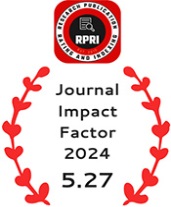The Roshani Movement and Literary School Exhibit these Characteristics
DOI:
https://doi.org/10.55544/ijrah.2.6.38Keywords:
Religious, Politics, Literature, Mystics, MovementAbstract
The purpose of this study is to investigate the various viewpoints held by academics and researchers regarding the nature of the Roshàni movement. These viewpoints are then divided into three categories: national, mystical, and common. The characteristics of the Roshàni movement and its effects on Pashtu literature are also covered in this article. Mixed methods (observation and the library) are applied in this article. The article's introduction, main topic, conclusion, and references are presented in that order, starting with the abstract.
Downloads
References
Khadim, Qayam. (1323, AC). Bayazid Roshan, Pashtu Community: Kabul
Khushki, Muhammad Sabir. (1392 AC) Pashtu Mansoor Matoon, Mustaqbal publishing, Community: Kabul
Rohi, Muhmmad Sadiq. (1386 AC) literary research, Danish publishing community: Peshawar
Zaywar, Zay Al Din. (1386 AC) history of Pashtu literature (middle ages) Safi Pashtu research and development center: Peshawar
Mamozia, Sahib Gul. (1388 AC) memory of Ba Yazayid Roshan, educational academies of language and literature center
Nagar, Fazal Wali. (1390 AC) mystical school of Bayazid Mehin publishing community
Hashmi, Sayed Mohiden. (1395 AC) literary theory Mehin publishing Community: Peshawar
Hewad Mal Zalmi. (1379 AC) history of Pashtu literature (ancient and middle ages): Danish Publishing Community
Downloads
Published
How to Cite
Issue
Section
License
Copyright (c) 2022 Integrated Journal for Research in Arts and Humanities

This work is licensed under a Creative Commons Attribution-NonCommercial-NoDerivatives 4.0 International License.




















